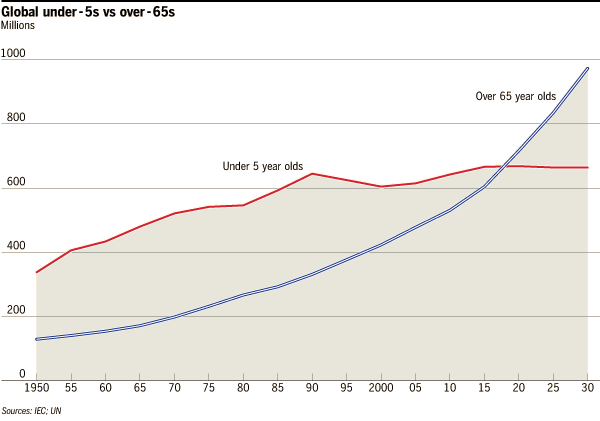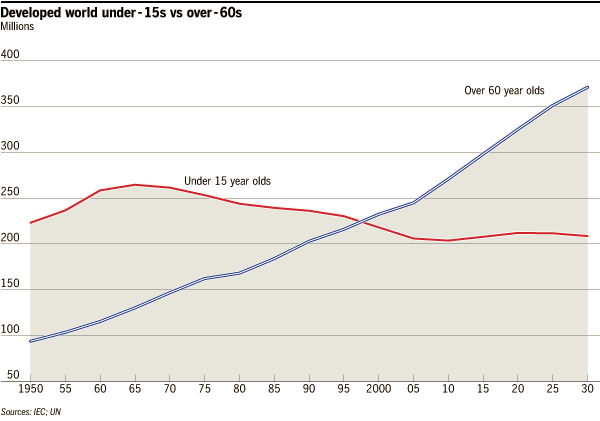The blog’s latest post for the Financial Times FT Data blog is below. The industry is going through major difficulties, which is bad news not only for its suppliers of plastic and other components. It is also a problem for China, which manufactures 70% of the world’s toys.
The toy industry is going through difficult times as Lex highlighted recently. Profits at Toys R Us have halved since 2009, whilst Mattel is suffering due to poor sales of Barbie dolls. A dismal Christmas at the UK’s Mothercare led the departure of its chief executive.
This is not just due to competition from electronic games. Instead, the toy industry’s woes have a more fundamental cause. Falling fertility rates around the world mean that its end-user market, babies, has gone ex-growth. OECD data shows that one in seven American women for example, end their child-bearing years without children.
Chart 1: The world will soon have more people aged over 65 than under five
As Chart 1 shows, the world’s population has also now reached a tipping point, where there will soon be more over-65s alive than under-fives. By 2020, there will be 716 million over-65s compared to only 668 million under-fives, according to UN population division forecasts. This is a major paradigm shift, caused by the halving of global fertility rates since 1950, combined with a 50 per cent increase in global life expectancy, as discussed in my last post “Adapting to the aging baby boomers”.
Chart 2: The Western world already has more over 60s than under 15s
Demographics drive demand, and the toy industry is thus acting as the proverbial ‘canary in the coalmine’. It is warning of the likely consequences of this paradigm shift for a wide range of current business models, which have traditionally focused on either the 15 – 59 age group, or on children.
The reason is that we are now at the inevitable end-point of a process that began several decades ago in the more developed regions of the world, at the end of the baby boom:
- The over-65s began to outnumber the under-fives as long ago as 1970 in these wealthier regions. Today, there are three times as many in the over-65 generation, 220 million versus 70 million
- As Chart 2 highlights, the year 2000 marked the next stage in the paradigm shift, when the over-60s began to outnumber the under-15s
Today, an even more important change is taking place in these regions. A long-term decline is now underway in the size of the 15 – 59 population itself. This peaked at 766 million in 2010, and is forecast to decline 7 per cent to 714 million by 2030. It is expected to number just 675 million by 2050.
Many boardrooms and investment committees have yet to wake up to the far-reaching implications of these unprecedented developments. They instead continue to assume that businesses should focus on their traditional markets, whilst unfairly stereotyping the over-60s as being just a small niche market for products such as walking aids, retirement homes and healthcare.
But it is hard to increase revenues and profits when the size of your potential customer base is shrinking. Companies who instead focus their efforts on developing new products and services aimed at the growing number of older people, are likely to be much more successful. A suitable motto for boardroom walls might therefore be Graham Bell’s great insight, “sometimes we stare so long at a door that is closing, we see too late the one that is open”.


